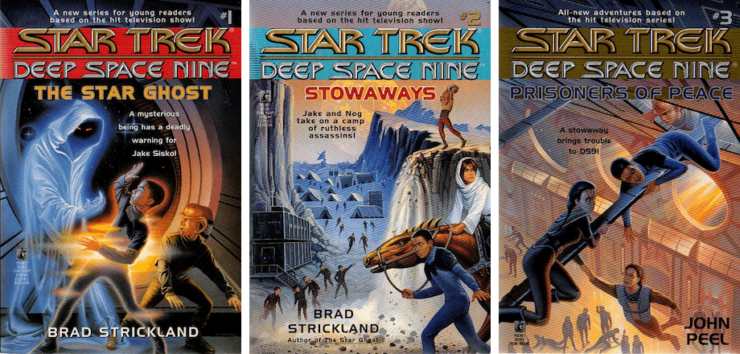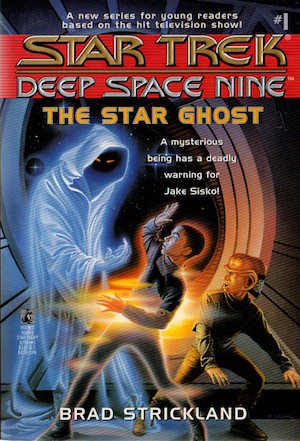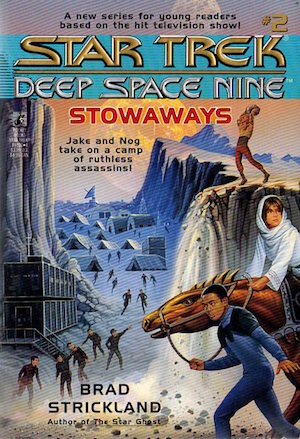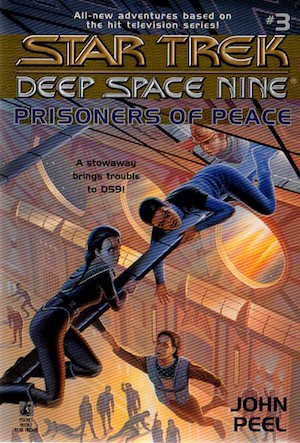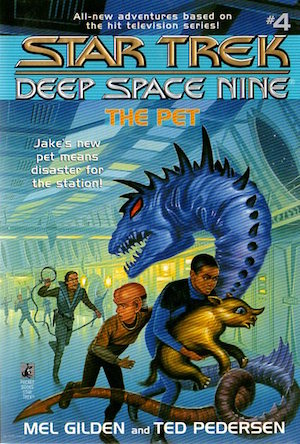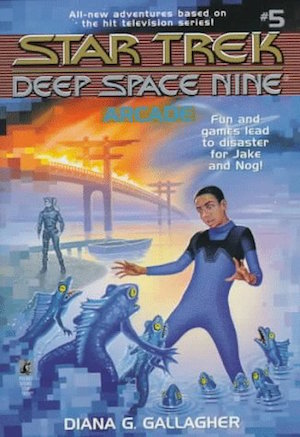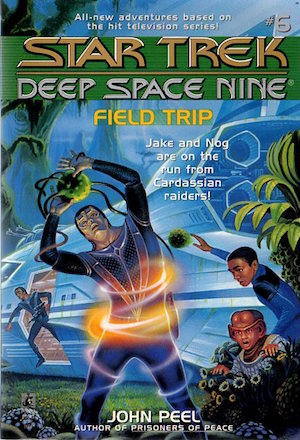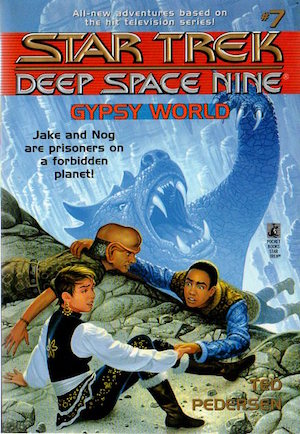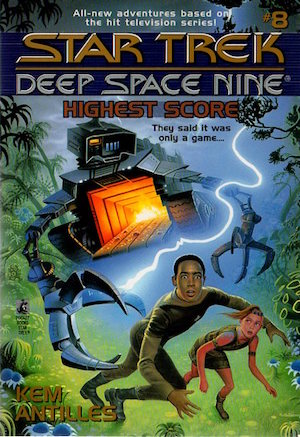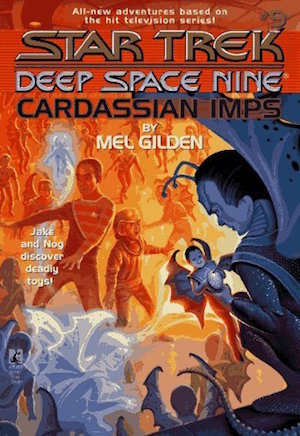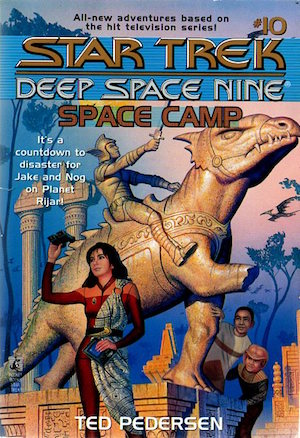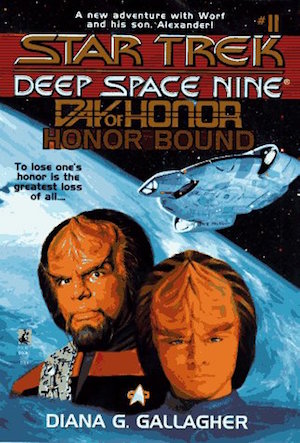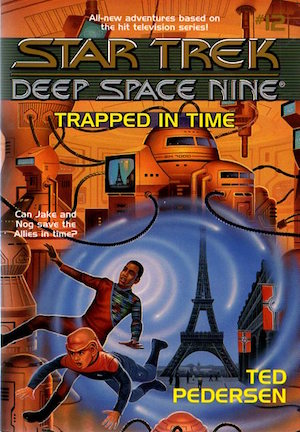I entered 2018—which marks the Star Trek: Deep Space Nine’s 25th anniversary—lacking the time to re-watch the series but nevertheless harboring a desire to spend time in its extended universe. To satisfy that impulse I read some of the Malibu DS9 comics, I listened to the various DS9 soundtracks, and I watched the supplemental features on the DVD sets. In mid-October I was fortunate enough to attend the L.A. premiere of the marvelous commemorative documentary What We Left Behind, where I had the pleasure of meeting some of the show’s cast and crew, a truly memorable experience. And all through 2018 there was another way in which I kept the DS9 flames burning: by reading some of the show’s tie-in books.
Including novelizations, anthologies, cross-overs, and the official re-launch stories, there are almost one hundred adult DS9 fiction books. These certainly merit a full discussion, or several—and indeed have been covered, piecemeal at least, elsewhere. I’d read some of these novels decades ago and enjoyed them, but as with the show itself, I realized I didn’t have the time to work my way through them now in any systematic way. That’s when I remembered that between 1994 and 1998 twelve young-adult DS9 novels were published concurrently with the adult books. I hadn’t seen much written on them. They looked breezy and fun; they promised a playful recreation of the show’s key characters, particularly Jake and Nog; and they were short enough that I could read the entire series. Also, DS9 itself can be somewhat gloomy, and the idea of a less grim, more high-spirited approach provided additional allure.
And so here we are.
As I began reading these books, I soon realized they follow a pretty similar narrative template, with some ingenious variations along the way: Jake and Nog get into trouble, either on the station or, more colorfully, on various planets, they have adventures and make new friends, and in the end all is resolved. The greatest joy (reading these books as an adult, at any rate) lies in the small details, and the manner in which the novels are in dialogue with the series. Thus, what follows are not plot summaries or reviews, but rather some selected observations on elements I found diverting. Author comments are sourced from Jeff Ayers’ Voyages of Imagination: The Star Trek Fiction Companion.
The Star Ghost by Brad Strickland
This title commands one’s attention: Star Trek goes Supernatural? Not quite. The “ghost” in question is a Ferengest, which is to say a Ferengi spectral entity whose presence correlates with violated customs or, according to the author, “negative fiduciary powers”. How apropos that Quark and Nog should be concerned.
This story gets off to a pretty slow start, and to buy in to the central conceit you’ll have to expend significant suspension of disbelief (think wormhole-aliens level).
One thing that came to mind as I read it was a certain similarity with the season 5 episode of Star Trek: The Next Generation, “The Next Phase”. That episode aired in May 1992, and this book was published in February 1994. I’d be curious to know if Brad Strickland—or his wife Barbara, whose work on this was uncredited—remembers being influenced by that storyline in any way.
Stowaways by Brad Strickland
Sometimes the YA novels wound up influencing the show in small but interesting ways. In Stowaways, Julian Bashir plays at being a secret agent, an aspect of his character that would later inform various episodes of the series, starting with season 4’s “Our Man Bashir”. The author was naturally “delighted” when this happened.
For anyone considering reading these books, this may be the ideal entry point. The story moves reasonably briskly and unfolds off the station. Bajor is nicely evoked through descriptions of its religious customs, landscapes and so on.
Prisoners of Peace by John Peel
The writers of this series made up their own Rules of Acquisition at their peril. Case in point, on page 109 John Peel gives us the Ferengi’s Third Rule as the somewhat unimaginative “I found it; it’s mine”, but season 2’s “The Maquis, Part II” actually revealed the Third Rule as “Never spend more for an acquisition than you have to.” The timing on this one is interesting; the episode aired in May 1994, while Peel’s book was published in October 1994. So it’s not clear when the manuscript was handed in, and whether that preceded the writing of the script.
Peel also references the Seventy-Sixth Rule on the same page: “Every once in a while, declare peace.” This turns out to be a slightly truncated version of the same Rule as provided in the season 2 opener, “The Homecoming” (which aired in September 1993): “Every once in a while, declare peace. It confuses the hell out of your enemies.”
I’ll mention a few other Rules as we move through the rest of the series, because greed is eternal (Tenth Rule).
Also, if you decide to read this book—which features a “sympathetic Cardassian character” in a pretty slight story—prime the nearest neuralyzer to help you forget what you’ve seen on the cover, as it essentially spoils the climax.
The Pet by Mel Gilden and Ted Pedersen
Self-sealing stem bolts are one of my favorite bits of DS9 technobabble, knowingly unknown and perhaps unknowable—their self-sealing nature nicely echoes this suggested meta-element—and with a nicely alliterative ring. It was thus a delight to encounter them in the fourth entry in this series, even if on page 20 they’re spelled “self-sealing stenbolts”.
In another nod to the absurdist, we also get a ten-foot high volcano of red-hot chocolate lava on page 35. Yum.
Ted recalls that this novel’s basic plot was inspired by Robert Heinlein’s Star Beast, which I now really want to read, surely for the wrong reasons.
Speaking of references, this one is pretty cool:
“We need to play detective,” Jake said.
“Like in Sherlock Holmes and the Cardassian Corpse?” Nog asked. —p. 48
Over the years the Sherlockian cosmos and the Trek universe have commingled. Lynne Stephens’s essay “Beam Me Up, Sherlock”, published in Sherlock Holmes Mystery Magazine, details some of those connections. It’s nice to find an addition to the list.
Arcade by Diana G. Gallagher
As a fan of the Original Series episode “The Ultimate Computer”, and someone who enjoys hearing the name Daystrom Institute regardless of circumstance, it was fun to see a reference to Daystrom’s invention of the duotronic computer in the first chapter of Arcade.
The Fifty-first Rule, we’re told on page 11, is: “Reward anyone who adds to your profits so they will continue to do so.”
The Thirty-Seventh Rule, we learn on page 26, goes thusly: “If it’s free, take it and worry about hidden costs later.”
Unlike other Rules in these books, these wasn’t later contradicted by the show, not that that makes much difference. They sound pretty sensible to me.
I’ll note that this is one of my favorite books in the lot, and I’m partial to the cover, which though somewhat apparently surreal accurately depicts a scene in the story. The reference to Dhraako also adds a welcome bit of continuity with The Star Ghost.
Field Trip by John Peel
The Star Ghost is again referenced in this novel, when on page 74 Jake says, “I had enough problems with my last ghost; this character had better be flesh and blood.” Indeed!
During the titular expedition, a character named Ashley decides to name a certain “cabbage-thing” a Screaming Mimi. This is an homage by Peel to writer Frederic Brown, following the title of one of Brown’s mystery novels.
I was amused by the speech patterns of the captive introduced in Chapter 10. “Talk you should,” “Hurt me you won’t?”, “Possible is not,” and so on are all very Yoda-like.
Plot-wise, the book feels a bit lopsided, with a few too many revelations about the Trofars being piled on during the last few pages.
Gypsy World by Ted Pedersen
The banter between Odo and Quark never gets old, and Odo’s crankiness, in particular, shines in this book’s early chapters.
“Always know the competition” is given as Rule 218 (p. 38)—I would have expected this to be a much higher number!
The term for not-quite-human used by the alien species Fjori is given as “gajo” (p. 52). In Spanish that means “segment” or “slice.” Hmmm.
Apparently, Jake competed in the Starfleet Youth Olympics on Mars—and defeated a Klingon opponent. Lean but mean; good for him!
Ever hear of the Rocket Rangler (perhaps a distant cousin of Rocket Raccoon)? According to this book, he’s Jake’s favorite holosuite hero, and Jake is fond of using the Rangler’s catchphrase, “Here goes the galaxy” (p. 80). I wonder if Pedersen opted to omit the “w” from the second name to avoid referencing the famous race horse.
Highest Score by Kem Antilles (Kevin J. Anderson and Rebecca Moesta)
This novel is basically the love child of The Last Starfighter and Ender’s Game. By the time I got to it, I admit I was a little weary of storylines involving simulations.
On a more positive note, I’m fond of Jake’s character arc throughout DS9’s seven seasons, including his decision to not enroll in Starfleet and instead to become a writer. Jake is penning poetry by Season Three’s sixth episode, “The Abandoned”, and considers accepting a writing fellowship from the Pennington School by the same season’s twenty-second episode, “Explorers”. With the help of a mysterious alien, Jake goes on to write a novel in season 4’s “The Muse”, shown in April 1996, and so on. It’s nice to see Highest Score, published in February 1996, acknowledging these developments with an early scene in which Sisko encourages Jake to “concentrate on his writing” (p. 11).
Some more Rules of Acquisition to chomp on, none of which were superseded by the series:
- Rule Eighty-Seven: “Learn the customer’s weaknesses so you can better take advantage of him.” (p. 13)
- Rule Twenty-Nine: “What’s in it for me?” (p. 25)
- Rule Ninety-Two: “There are many paths to profit.” (p. 82)
Remember the Benzites? Here they’re characterized as having “a reputation for thinking they were better than everyone else” (p. 45). I can see how one might arrive at that interpretation, but it doesn’t really square with my impression of them from various episodes. I won’t tell Mordock if you don’t.
Cardassian Imps by Mel Gilden
Perhaps unsurprisingly, we learn that Sisko is a fan of cayenne pepper, and it takes him a while to get the replicator to produce an acceptable facsimile (p. 3).
Two more Rules:
- Rule Twenty-Two: “Wise men can hear profit in the wind.” (p. 10)
- Rule Sixty-Two: “The riskier the road, the higher the profit.” (p. 44)
Kudos to Mel Gilden, as both are close textual variants of the rules as stated in the season two episode “Rules of Acquisition”.
Another Daystrom reference that gives me a kick:
“The Trulgovians are not the brightest race in the galaxy,” Odo explained. “They make Pakleds look like Daystrom Institute graduates.” (p. 52)
Ever hear of the Nimijk? According to Garak, the Nimijk is “the mythological beast of plenty” (p. 74). They have four wings, antennae, and a tail, but otherwise resemble ordinary Cardassians. Yowzers.
Space Camp by Ted Pedersen
Another top entry in the series for me, with a deft balance of planetary adventure and solid characterization in the service of classic Trek ideals. Because of that, I’m not going to spoil much.
I will say that at the outset of Space Camp Nog is not particularly interested in Starfleet Academy, though the events of this novel alter his perspective. This thread is explored and brought to fruition in season three of the series. Think of this as additional behind-the-scenes motivation.
Oh, and it’s nice to see that Arthur C. Clarke is still read and enjoyed in 2370, according to one of Jake’s new friends in this tale:
“His vision of space still survives, even if it is a bit technically out of date. His books inspired me to work on getting into Starfleet.” (p. 49)
Day of Honor: Honor Bound by Diana G. Gallagher
Another strong entry, this time tying in to the episode-centered and multi-volume Day of Honor concept. It’s refreshing to get a DS9 book focused on Worf and his son, and I can’t resist quoting the opening line: “Alexander Rozhenko was one-quarter human, three-quarters Klingon and totally furious!”
According to this story, and consistent with what we’re told in “The Way of the Warrior”, after the destruction of the Enterprise-D on Veridian III in Star Trek: Generations, Worf spends time at the Boreth Monastery.
There are numerous other nice bits of interwoven continuity, most related to the events leading up to the Dominion War (though the chronological meshing is suspect), and of course Klingon rites and characters, such as the suv’batleth (here spelled Suv’batlh, p. 59) and a reference to K’mtar, the future version of Alexander Rozhenko himself as seen in the TNG episode “Firstborn”.
Also, gymnastics for the win! (Pun intended if you read the book.)
Trapped in Time by Ted Pedersen
This series ends with either a bang or by going bonkers, depending on your mood. Personally, I think of this finale as charmingly wacky. I will say, the establishing Prologue, featuring the two Department of Temporal Investigations agents Dulmur and Lucsly interviewing Jake, sets the tone perfectly.
This book’s time-travel, D-Day, and Changeling antics admittedly distracted me from some of its numerous references, but I did appreciate this one:
Fortunately, O’Brien, who had played a hundred Battle of Britain simulations with Dr. Bashir in Quark’s holosuites, knew enough World War II history to come up with what he hoped was a convincing story. (p. 84).
Hopefully Keiko was pleased by this development. Of course we all knew those simulations would come in handy one day.
Looking back, too, I suppose an argument can be made that this novel anticipates the basic plot of the two-part Enterprise episode “Storm Front” and “Storm Front, Part II”.
*Spoiler Alert*
These lines of dialogue are spoken by Picard (!):
“My brother and I never got along. He was the traditionalist. Continuing the Picard family line was so important to him.” Picard looked at Jake. “You know there was a Picard who fought at Trafalgar… and Picards who settled the first Martian colony. When Robert married and had a son, well, I no longer felt a need to carry on the family line.” (p. 103)
Compare this to Picard’s exchange with Counselor Troi in Generations:
Picard: …from being a small child, I can remember being told about the family line. The Picard who fought at Trafalgar. The Picard who won the Nobel Prize for chemistry. The Picards who settled the first Martian colony. When Robert married and had a son, I…
Troi: …You felt it was no longer your responsibility to carry on the family line.
Picard: Right. Yes. That’s it exactly.
The similarity is a little too overt for my tastes, but hey, you can’t fault the consistency.
I really liked the novel’s final “shot”, too, which sees Jake anticipating the future. Onward and out.
There you have it! Hopefully these somewhat scattershot observations, and whatever reader comments follow, will be enough to entice you to take your own warp run through this likely little-navigated byway of the DS9 expanded universe.
If so, may the Prophets be with you!
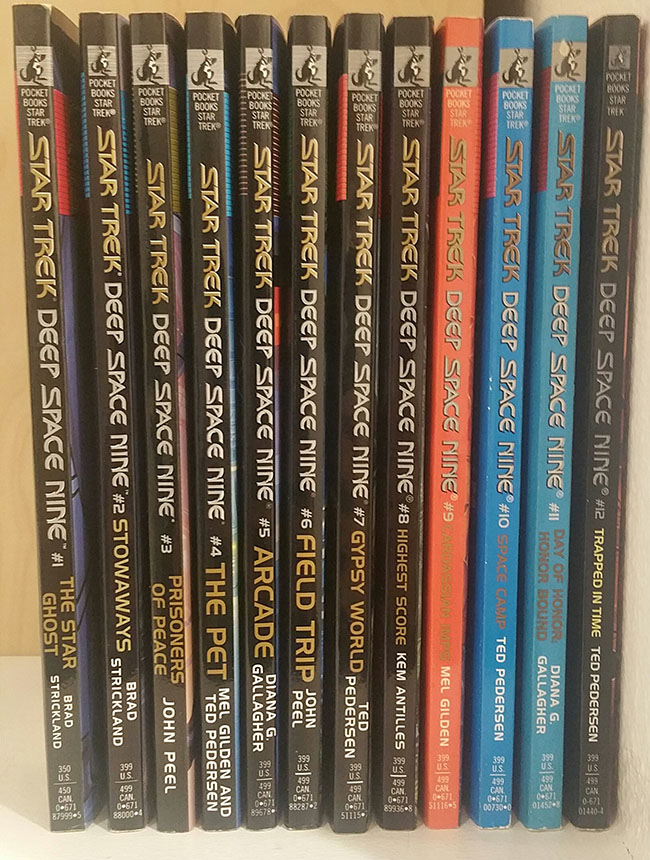
Alvaro is a Hugo- and Locus-finalist who has published over forty stories in magazines and anthologies, as well as numerous essays, reviews, and interviews. Nag him, or don’t, @AZinosAmaro.










